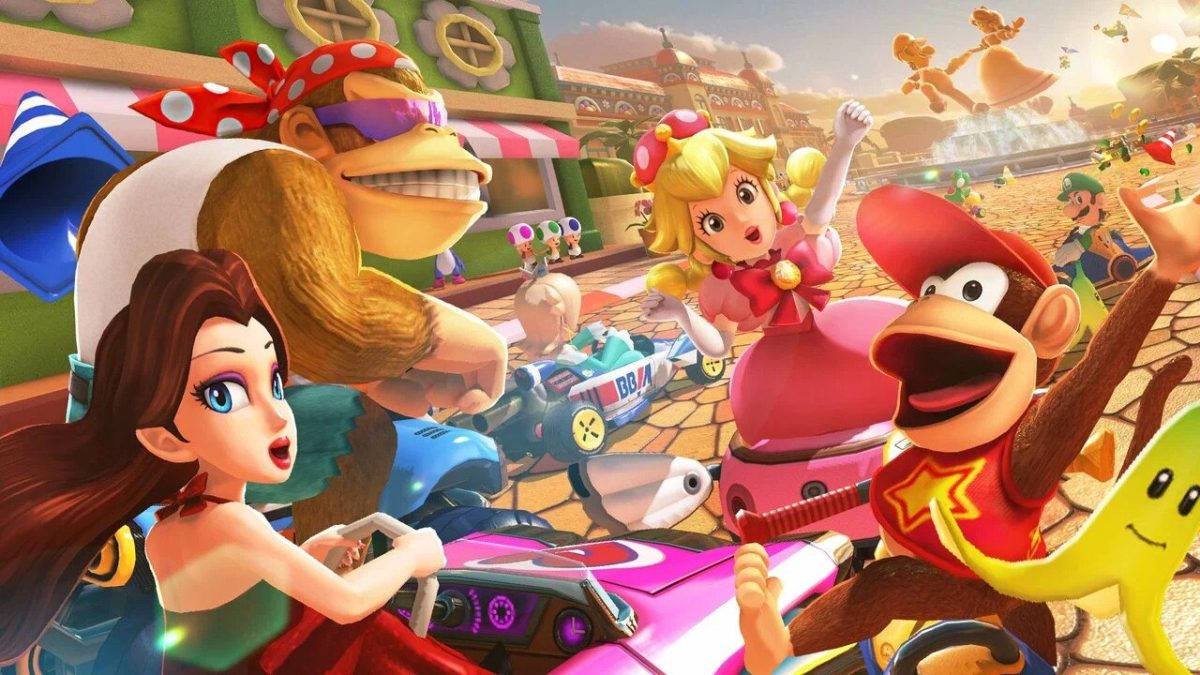On Nov. 8, Nintendo released the sixth and final wave of new tracks to “Mario Kart 8 Deluxe” as part of the “Booster Course Pass DLC.” This update also added four new characters and included a controversial balance change to the game’s item system.
A few minor additions were released in this update. There is now a “Music” button in the main menu that allows players to listen to the music from any base game or DLC track, even if they have not bought the Booster Course Pass. Nintendo has also made it possible for players to join online racing rooms by entering a Room ID. Finally, 17 Mii Racing Suits were added for those who purchased the Booster Course Pass.
The four new characters are Funky Kong, Diddy Kong, Pauline and Peachette. Funky Kong, who was one of the most requested characters by fans of the franchise, is a heavyweight who first appeared in “Mario Kart Wii.” Diddy Kong, another character whom fans wanted to see, is a middleweight who debuted in “Mario Kart: Double Dash!!” for the GameCube, and later returned in “Mario Kart Wii.” Pauline is a heavyweight whose first appearance was in the mobile game “Mario Kart Tour,” and had fans who wanted to see her appear in another major game. But Peachette, a middleweight who first appeared in “Mario Kart Tour,” was a character whom nobody was expecting. Nintendo certainly listened to its fans when choosing the last characters to include in the Booster Course Pass, so Peachette’s inclusion was certainly an interesting choice.
Some “Mario Kart 8 Deluxe” players employ a strategy called “bagging”—short for “sandbagging” and often also called “item smuggling”—in which players purposefully lag behind during a race so that they’re awarded more powerful items from the regenerating Item Box, such as Bullet Bill or the Golden Mushroom. This strategy often works because the items that a bagging player can acquire only become better as the distance increases between that player and the player in first place. Bagging has been controversial for a long time in the “Mario Kart 8 Deluxe” community, with some players considering it a valid strategy, while others think that there should not be an incentive to lag behind in a racing game. With this recent update, Nintendo decided to severely nerf bagging by making it so that a player cannot obtain powerful items from an Item Box by stopping or driving in reverse, or by sitting at the same regenerating Item Box multiple times in a lap. This drastic balance change has received much condemnation and praise from fans and opponents of bagging alike, and there is a lot of debate in the community about whether bagging is simply nerfed or outright dead.
Like the previous five waves, this DLC includes two Grand Prix with four tracks each, bringing the total number of DLC tracks to 48. The base game with the Booster Course Pass DLC now boasts 96 tracks, a number which is three times greater than the track count of any of the last several editions in the franchise, excluding “Mario Kart Tour.”
The Acorn Cup
This Grand Prix opens with Rome Avanti, a track from “Mario Kart Tour.” Like most other city tracks, this one’s layout changes with each lap, and it takes racers through many landmarks in Rome, such as the Colosseum, the Roman Forum, Trajan’s Market and the Trevi Fountain. Players must take many winding turns, with only a few off-road shortcuts available. Fuzzies serve as aerial enemies on one of the glider sections, and there is a bridge that is guarded by two Chain Chomps. The nighttime visuals of the track are gorgeous, but the music is nothing special. Overall, Rome Avanti is a charming and fun track, but it does not have much that makes it stand out among the other tracks in this wave.
6/10
Next comes DK Mountain from “Mario Kart: Double Dash!!” and later “Mario Kart Wii.” This iconic track has been visually enhanced in the new wave, and received few major changes to its core design. Players still ascend a giant mountain through a cannon and must descend by maneuvering through sharp turns as boulders fall. The major ravine shortcut near the end of this track is still possible, and the bridge in this version was made wavy and trick-able. The track’s visuals are gorgeous, and the music is nostalgic and exciting. DK Mountain is a difficult track to play well, but it is a joy to race and a notable highlight in this wave.
9/10
The third track in this Grand Prix is Daisy Circuit from “Mario Kart Wii.” This track also received few major changes to its layout: The figure-8 section is unchanged, the elevated sidewalk still wraps around part of the track and the narrow off-road staircase is still there, but it now has a Glide Ramp. Also, Dash Panels were added around the tight hairpin turn. While the track presents no real obstacles, its curved paths can be tough to drive well. The track’s visuals are bright and colorful, and its music is rather calming. Daisy Circuit is an enjoyable and iconic track whose inclusion is a great addition to “Mario Kart 8 Deluxe.”
8/10
This Grand Prix ends with Piranha Plant Cove from “Mario Kart Tour.” This track—which resembles an abandoned temple—has a different layout each lap, and it is one of the few tracks in the series to take place almost entirely underwater. The course is full of interesting creatures, including Thwomps, Cheep Cheeps, a giant Maw-Ray and a Clampy. There are also several off-road shortcuts in the third lap. The dark visuals of this track are beautiful, and its nautical music is unique. While Piranha Plant Cove is average in terms of its difficulty, its underwater setting and unique design make it a great experience for players of all skill levels.
8/10
The Spiny Cup
The last Grand Prix of the Booster Course Pass opens with Madrid Drive from “Mario Kart Tour.” This city track’s layout changes with every lap, and it takes players through famous icons that include the Gran Vía, the Plaza Mayor and the Prado Museum. The track features a sleeping Wiggler in the first lap who wakes up in the next lap, Thwomps and a giant Piranha Plant in a torn painting. Before the end of the last lap, players pass through the Santiago Bernabéu Stadium where Shoe Goombas kick massive soccer balls at them. The track’s visuals are nice, and its Spanish flamenco music is very fitting. Madrid Drive is certainly one of the best city tracks in the Booster Course Pass and a great choice for the final wave of tracks.
7/10
The next track is Rosalina’s Ice World from “Mario Kart 7” for the 3DS. With the exception of a new shortcut over a wooden ramp before the final turn, this track has basically not changed at all. The three-quarters turn on a thin strip of ice beside a chasm at the start of the lap is extremely difficult to pull off smoothly; it is not possible in this version to skip this turn by leaping over the chasm. The track splits in half twice, once before the underwater section and once in the cave section. The track is slippery to drive on, and penguins slide around as obstacles. The track’s blue and purple visuals are beautiful, and the music is nice and relaxing. Rosalina’s Ice World deserves to be included in the last wave of the Booster Course Pass as a tough challenge for even the best of players.
8/10
The penultimate track of the Booster Course Pass is Bowser Castle 3 from “Super Mario Kart” for the SNES and later “Mario Kart: Super Circuit” for the Game Boy Advance. This track has received a significant visual overhaul since its first two iterations. The whole course is surrounded by lava, and there are fireballs and columns of fire that add to the atmosphere. The track is relatively simple, but it has a few split routes and a large shortcut through mud. Two Bone Piranha Plants and several Thwomps serve as obstacles. The track has remarkable visuals and some of the best and most exciting music in the game. Though Bowser Castle 3 is a relatively simple track, it makes for an epic racing experience and a great addition to the last wave of tracks.
8/10
Many fans wanted it, and they received what they asked for: The last track in the game is now officially Rainbow Road from “Mario Kart Wii.” This nostalgic track retains all its charm and difficulty, forcing players to race on a wavy track in outer space, often with no guard rails. One of the notable shortcuts over a gap of space is still possible, and players also burst into flames when they fall off the track. This difficult track is sure to challenge all players as they maneuver through half-pipes, open gaps and dangerous turns. The beautiful visuals and music are, without question, among the best in the game. Nintendo could not have picked a more exciting and extraordinary track with which to conclude the Booster Course Pass.
10/10
Regarding whether the Booster Course Pass is worth buying, I can only reply with a resounding “Yes!” Forty-eight tracks for $24.99 comes out to about 52 cents per track, which is totally worth it considering how good so many of the tracks are and how much they can be replayed. “Mario Kart 9” probably will not come out for a long time, so playing “Mario Kart 8 Deluxe” with 96 total tracks is the best racing experience that one can have at the moment.
For those interested in the total ratings that I gave to each wave, I tabulated them all by adding the points I assigned to all eight tracks in each one. The ranking, from worst to best, goes Wave One (55 points), Wave Four (56 points), Wave Three (58 points), Wave Five (59 points), Wave Two (61 points) then Wave Six (64 points).
It is with great sadness that I must conclude this series of articles that began over a year ago. I had a wonderful time writing about Mario Kart, to the dismay of much of The Observer’s Editorial Board. It amazes me to think about the thousands of people who have read my reviews. I give great thanks to all of you, and perhaps some day we will meet unknowingly in an online “Mario Kart 8 Deluxe” lobby. In the meantime, I will be busy searching for my next great obsession.



